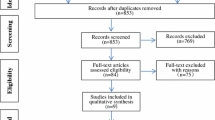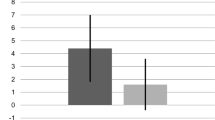Abstract
Purpose
The purpose of this study was to compare the effectiveness of a flexion spacer in the clinical and radiological outcomes of patients who underwent total knee arthroplasty (TKA) and to compare these patients to a group of patients subjected to the same type of surgery but without the use of a flexion spacer. It was hypothesized that patients who underwent TKA using a flexion spacer would have better clinical and radiological outcomes than those without a flexion spacer in both short- and medium-term follow-ups.
Methods
A consecutive series of patients undergoing TKA were included, yielding 20 patients in the study group. The control group was identified from the consultant database of the senior author, yielding 21 patients who underwent the same operation. All 41 patients received a Vanguard Knee System (Zimmer-Biomet, Warsaw, Indiana, USA). Cases were defined as those patients who had undergone TKA using a flexion spacer device for gap balancing; controls were defined as patients who had undergone TKA without the support of a flexion spacer device. Patients were clinically and radiographically evaluated at two consecutive follow-ups: T1—13.1 ± 1.3 months and T2—108 ± 6 months. Clinical evaluation was performed using the Knee Society Scoring System and the Western Ontario, McMaster Universities Osteoarthritis Index score. Radiographic evaluation included the femoral angle (α), the tibial angle (β), the sagittal femoral (γ) angle and the tibial slope (δ). Furthermore, the lateral patellofemoral angle (LPFA) and the Caton-Deschamps index were evaluated.
Results
No statistically significant clinical differences were found between the two groups at T1 and T2; moreover, the clinical outcomes of the two groups were stable between the two follow-ups, with no significant improvement or worsening. Radiographic evaluation showed no difference in the two groups between T1 and T2; the only significant radiographic difference between the two groups concerned the LPFA (both at 30° and 60°) at each follow-up, which was significantly greater in cases than in controls (p = 0.001).
Conclusions
The current study demonstrates that the use of a flexion spacer significantly improves radiographic patello-femoral tracking, although no significant clinical differences were found between the two groups.
Level of evidence
Case–control study, level III.





Similar content being viewed by others
References
Aït-Si-Selmi T, Marie-Hardy L, O'Loughlin PF, Kobayashi K, Müller JH, Saffarini M, Bonnin MP (2020) Patellar facet ratio affects knee pain, stair climbing and stair descent after TKA without patellar resurfacing. Knee Surg Sports Traumatol Arthrosc. https://doi.org/10.1007/s00167-020-05868-y
Easterlin MC, Chang DG, Talamini M, Chang DC (2013) Older age increases short-term surgical complications after primary knee arthroplasty. Clin Orthop Relat Res 471:2611–2620. https://doi.org/10.1007/s11999-013-2985-8
Firer P, Gelbart B (2018) Balancing of total knee arthroplasty by bone cuts achieves accurately balanced soft tissues without the need for soft tissue. J ISAKOS 3:263–268. https://doi.org/10.1136/jisakos-2018-000217
Fitz W, Jäger S, Rieger JS, Seebach E, Bitsch RG (2017) Femoral rotation in total knee arthroplasty: a comparison of patient individualized jigs with gap balancing in relation to anatomic landmarks. Knee Surg Sports Traumatol Arthrosc 25:1712–1719. https://doi.org/10.1007/s00167-015-3836-9
Gao F, Ma J, Sun W, Guo W, Li Z, Wang W (2017) Radiographic assessment of knee-ankle alignment after total knee arthroplasty for varus and valgus knee osteoarthritis. Knee 24:107–115. https://doi.org/10.1016/j.knee.2016.09.023
Grassi A, Compagnoni R, Ferrua P, Zaffagnini S, Berruto M, Samuelsson K, Svantesson E, Randelli P (2018) Patellar resurfacing versus patellar retention in primary total knee arthroplasty: a systematic review of overlapping meta-analyses. Knee Surg Sports Traumatol Arthrosc 26:3206–3218. https://doi.org/10.1007/s00167-018-4831-8
Heller GZ, Manuguerra M, Chow R (2016) How to analyze the Visual Analogue Scale: myths, truths and clinical relevance. Scand J Pain 13:67–75. https://doi.org/10.1016/j.sjpain.2016.06.012
Huang T, Long Y, George D, Wang W (2017) Meta-analysis of gap balancing versus measured resection techniques in total knee arthroplasty. J Bone Jt Surg Br 99-B:151–158. https://doi.org/10.1302/0301-620X.99B2.BJJ-2016-0042.R2
Inoue A, Arai Y, Nakagawa S, Inoue H, Yoshihara Y, Yamazoe S, Kubo T (2017) Differences in patellofemoral alignment as a result of patellar shape in cruciate-retaining total knee arthroplasty without patellar resurfacing at a minimum three-year follow-up. Knee 24:1448–1453. https://doi.org/10.1016/j.knee.2017.08.050
Ip D, Wu WC, Tsang WL (2002) Comparison of two total knee prostheses on the incidence of patella clunk syndrome. Int Orthop 26:48–51. https://doi.org/10.1007/s00264-001-0316-2
Kavolus CH, Hummel MT, Barnett KP, Jennings JE Jr (2008) Comparison of the Insall-Burstein II and NexGen legacy total knee arthroplasty systems with respect to patella complications. J Arthroplasty 23:822–825. https://doi.org/10.1016/j.arth.2007.07.016
Kumar N, Yadav C, Raj R, Anand S (2014) How to interpret postoperative X-rays after total knee arthroplasty. Orthop Surg 6:179–186. https://doi.org/10.1111/os.12123
Leichtle UG, Wünschel M, Leichtle CI, Müller O, Kohler P, Wülker N, Lorenz A (2013) Increased patellofemoral pressure after TKA: an in vitro study. Knee Surg Sports Traumatol Arthrosc 22:500–508. https://doi.org/10.1007/s00167-013-2372-8
Liebs TR, Kloos SA, Herzberg W, Rüther W, Hassenpflug J (2013) The significance of an asymmetric extension gap on routine radiographs after total knee replacement: a new sign and its clinical significance. J Bone Jt Surg Br 95-B:472–477. https://doi.org/10.1302/0301-620X.95B4.31080
Manning WA, Ghosh KM, Blain A, Longstaff L, Rushton SP, Deehan DJ (2018) Internal femoral component rotation adversely influences load transfer in total knee arthroplasty: a cadaveric navigated study using the Verasense device. Knee Surg Sports Traumatol Arthrosc 26:1577–1585. https://doi.org/10.1007/s00167-017-4640-5
Matsumoto K, Ogawa H, Yoshioka H, Akiyama H (2017) Postoperative anteroposterior laxity influences subjective outcome after total knee arthroplasty. J Arthroplasty 32:1845–1849. https://doi.org/10.1016/j.arth.2016.12.043
Murphy BPD, Dowsey MM, Spelman T, Choong PFM (2018) The impact of older age on patient outcomes following primary total knee arthroplasty. J Bone Jt Surg Br 100-B:1463–1470. https://doi.org/10.1302/0301-620X.100B11.BJJ-2017-0753.R6
Nagai K, Muratsu H, Kanda Y, Tsubosaka M, Kamenaga T, Miya H, Matsushita T, Niikura T, Kuroda R, Matsumoto T (2018) Intraoperative soft tissue balance using novel medial preserving gap technique in posterior-stabilized total knee arthroplasty: comparison to measured resection technique. Knee Surg Sports Traumatol Arthrosc 26:3474–3481. https://doi.org/10.1007/s00167-018-4945-z
Prudhon JL, Caton JH, Aslanian T, Verdier R (2018) How is patella height modified after total knee arthroplasty? Int Orthop 42:311–316. https://doi.org/10.1007/s00264-017-3539-6
Rajgopal A, Dahiya V, Vasdev A, Kochhar H, Tyagi V (2011) Long-term results of total knee arthroplasty for valgus knees: soft-tissue release technique and implant selection. J Orthop Surg (Hong Kong) 19:60–63. https://doi.org/10.1177/230949901101900114
Salaffi F, Leardini G, Canesi B, Mannoni A, Fioravanti A, Caporali R, Lapadula G, Punzi L, GOnorthrosis, and Quality Of Life Assessment (GOQOLA) (2003) Reliability and validity of the Western Ontario and McMaster Universities (WOMAC) Osteoarthritis Index in Italian patients with osteoarthritis of the knee. Osteoarthr Cartil 11:551–560. https://doi.org/10.1016/s1063-4584(03)00089-x
Scuderi GR, Bourne RB, Noble PC, Benjamin JB, Lonner JH, Scott WN (2012) The new Knee Society Knee Scoring System. Clin Orthop Relat Res 470:3–19. https://doi.org/10.1007/s11999-011-2135-0
Tanikawa H, Tada M, Harato K, Okuma K, Nagura T (2017) Influence of total knee arthroplasty on patellar kinematics and patellofemoral pressure. J Arthroplasty 32:280–285. https://doi.org/10.1016/j.arth.2016.06.044
Tian F, Zang XH, Sun YS (2018) Impact of knee varus and valgus deformity on alignment in lower extremities after total knee arthroplasty (TKA). Eur Rev Med Pharmacol Sci 22:83–89. https://doi.org/10.26355/eurrev_201807_15368
van Duren BH, Pandit H, Pechon P, Hart A, Murray DW (2018) The role of the patellar tendon angle and patellar flexion angle in the interpretation of sagittal plane kinematics of the knee after knee arthroplasty: a modelling analysis. Knee 25:240–248. https://doi.org/10.1016/j.knee.2018.01.006
von Elm E, Altman DG, Egger M, Pocock SJ, Gøtzsche PC, Vandenbroucke JP, Initiative STROBE (2008) The strengthening the reporting of observational studies in epidemiology (STROBE) statement: guidelines for reporting observational studies. J Clin Epidemiol 61:344–349. https://doi.org/10.1016/j.jclinepi.2007.11.008
Westerman RW, Bhangoo NS, James P (2016) When and how is patella tracking best assessed in total knee arthroplasty surgery? J Knee Surg 29:337–340. https://doi.org/10.1055/s-0035-1554924
Funding
None.
Author information
Authors and Affiliations
Contributions
All authors contributed equally.
Corresponding author
Ethics declarations
Conflict of interest
The authors declare that they have no competing interest.
Ethical approval
Ethical approval was achieved from the local ethics committee.
Informed consent
Informed consent was obtained from all individual participants included in the study.
Additional information
Publisher's Note
Springer Nature remains neutral with regard to jurisdictional claims in published maps and institutional affiliations.
Rights and permissions
About this article
Cite this article
D’Elicio, D.G., Attanasio, M., Ruffo, G. et al. Improving radiographic patello-femoral tracking in total knee arthroplasty with the use of a flexion spacer: a case–control study. Knee Surg Sports Traumatol Arthrosc 29, 586–593 (2021). https://doi.org/10.1007/s00167-020-05991-w
Received:
Accepted:
Published:
Issue Date:
DOI: https://doi.org/10.1007/s00167-020-05991-w




